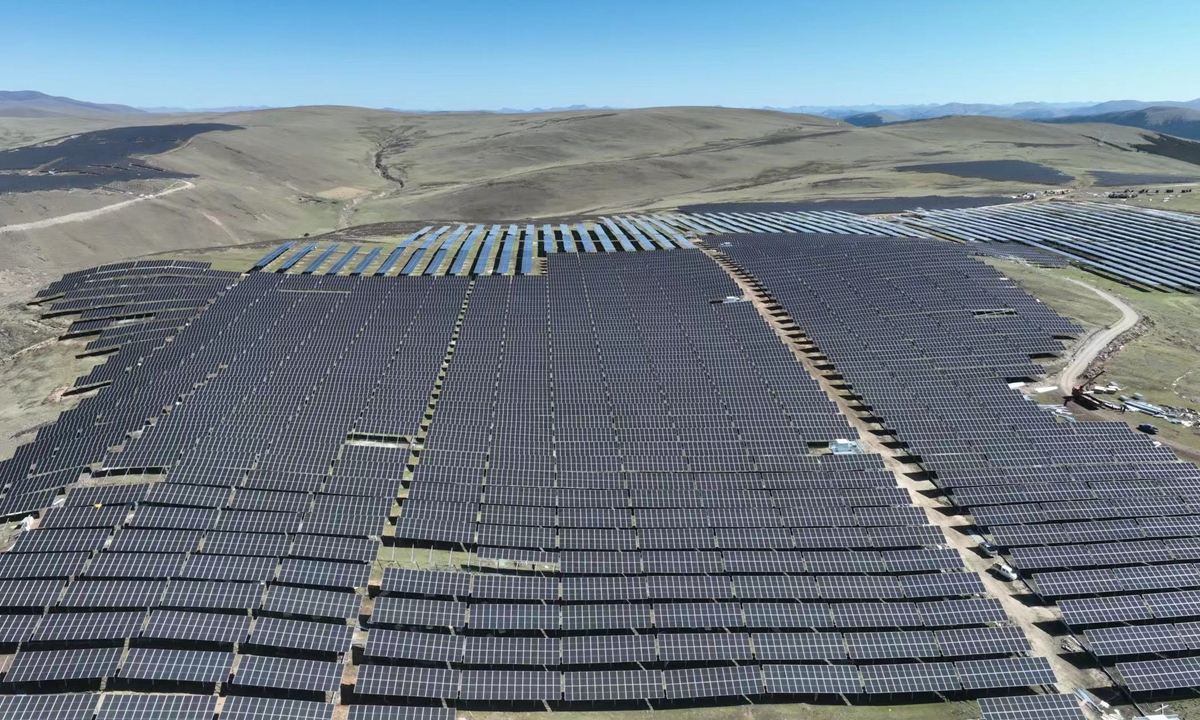
The Kela photovoltaic power station, the world's largest and highest-altitude hydropower and PV complementary power station, begins producing electricity in Southwest China's Sichuan Province on June 25, 2023. Photo: Courtesy of PowerChina Chengdu
The Kela photovoltaic (PV) power station, the world's largest and highest-altitude hydropower and PV complementary power station, began producing electricity on Sunday.
With the operation of the power station, located in the Yalong River Basin in Southwest China's Sichuan Province, the complementary operation between hydropower and PV has been elevated to a capacity of over 1 million kilowatts for the first time, as China strives to ensure energy security and achieve its "dual carbon" goals.
The project covers an area of around 16 million square meters, which is equivalent to 2,000 standard football fields. PowerChina Chengdu Engineering Co is responsible for the surveying, design, procurement, construction, commissioning, grid connection, and power generation for one-third of the project.
The project came as the instability, fluctuation, and intermittency of PV power generation has a certain impact on the safety of the power grid. Combining solar and hydro power is considered an effective way of making it more stable, the project's chief design engineer Wu Di told the Global Times.
The electricity generated by the solar panels will be connected to the Lianghekou hydroelectric power station, which was designed by PowerChina Chengdu, and then integrated into the power grid.
It is estimated that the project will save over 600,000 tons of standard coal annually and reduce carbon dioxide emissions by more than 1.6 million tons, a significant contribution to the rapid development of the new-energy industry in the region.
In addition to playing a demonstrative and leading role in achieving the goals of peak carbon emissions and carbon neutrality and optimizing the national energy structure, the project is also driving the development of industries such as agriculture, animal husbandry, tourism, and transportation in the adjacent ethnic minority regions.
During the construction process, PowerChina tried to employ as many local workers as possible.
Penpa Tsering, a local resident who participated in the new project, told the Global Times, "In the past, local residents used to make their living mainly through herding and going out to other areas for work. But things have changed, and now they can work right in their own neighborhood, earning an income and learning new skills at the same time."
PowerChina Chengdu took on the planning responsibilities for the Kela project in 2016, with feasibility design work commencing in 2021 and construction officially beginning in July 2022.
However, in completing such a massive project, the project developer had to overcome enormous challenges.
Located in the western part of Kela in Yajiang county, at an altitude ranging from 4,000 to 4,600 meters, the project's highest point is nearly 1,000 meters higher than Lhasa, the capital city of Southwest China's Xizang Autonomous Region.
The segment undertaken by PowerChina Chengdu is the one with the highest altitude, largest scale, largest area, and most complex terrain, project manager Li Tao told the Global Times.
Throughout the construction process, the project encountered various challenges, one of which was the low oxygen levels due to its high altitude - the oxygen levels at the project site were up to 50 percent lower than those in the plains.
Other challenges, including frequent extreme weather conditions such as strong winds, heavy snowfall, freezing temperatures, as well as tight deadlines, all posed a severe test for the construction.
The construction team used its experience gained from constructing numerous high-altitude projects, including the world's highest-altitude wind farm, to overcome the challenges.




